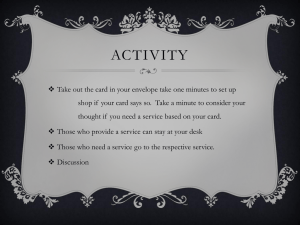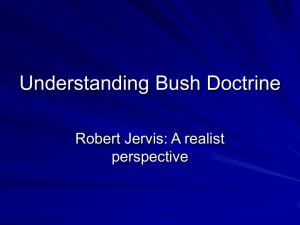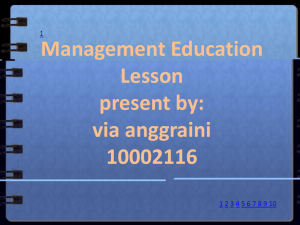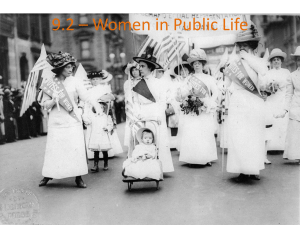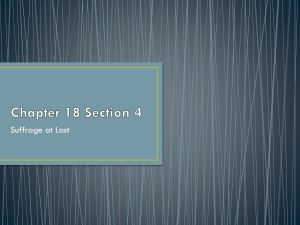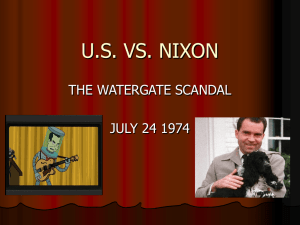Notes Packet ASE SS 02: Modern US History Steve Schmidt
advertisement
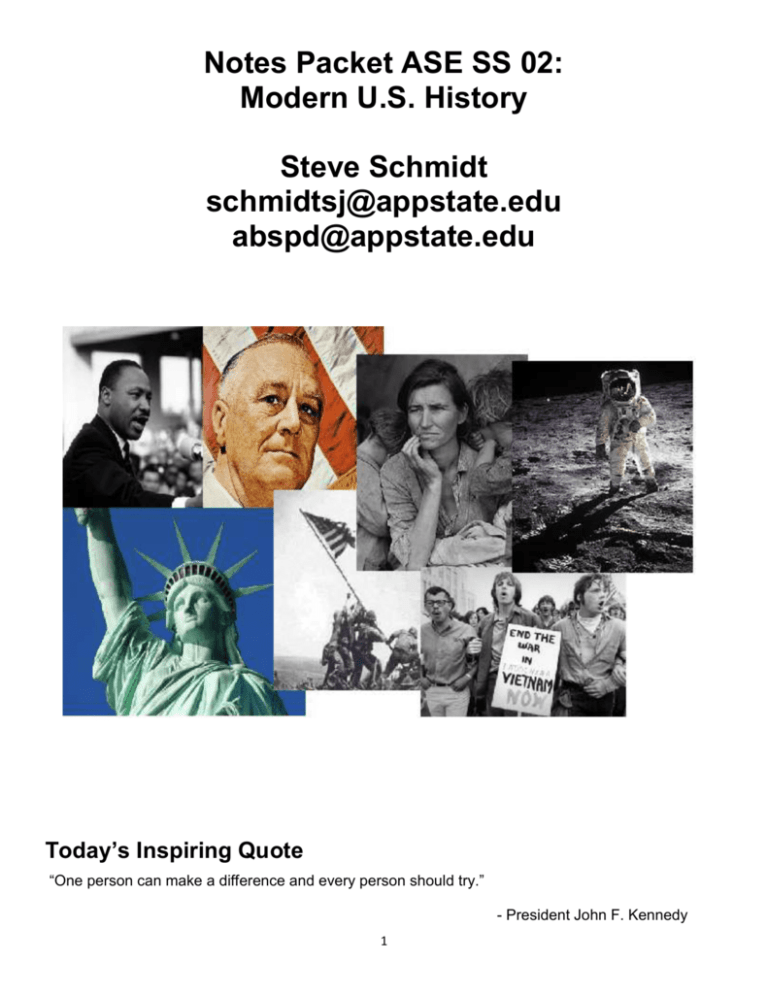
Notes Packet ASE SS 02: Modern U.S. History Steve Schmidt schmidtsj@appstate.edu abspd@appstate.edu Today’s Inspiring Quote “One person can make a difference and every person should try.” - President John F. Kennedy 1 You Can Write on the Packet! You can find everything from this workshop at: abspd.appstate.edu Look under: Teaching Resources, Adult Secondary Resources, Social Studies, ASE SS 02: Modern U.S. History. Workshop Schedule 8:30 - 10:00 Welcome and Introductions Sharecropping, Jim Crow, Segregation and Voting Rights 10:00 – 10:15 Break 10:15 – 11:45 Suffering for Suffrage 11:45 – 12:45 Lunch 12:45 – 2:00 Watergate TACOs History as Story 2:00 – 2:15 Break 2:15 – 4:00 Post 9/11 Foreign Policy: The Bush Doctrine This course is funded by: Workshop Goals Understand how to create units of study using U.S. History content from 1877 to the present Learn ways to teach students to integrate information from multiple sources Use multi-media resources and stories to make history come alive Understand and apply the College and Career Readiness standards for historical literacy and the North Carolina Essential Standards 2 Lesson 1: Sharecropping, Jim Crow, Segregation and Voting Rights This lesson focuses on life in the South from 1865 until the 1960s. It describes what life was like for many African Americans and poor Whites during this period (the majority of the population). It may take several class periods to complete. Materials Needed: - Sharecropper Simulation worksheet - Bags with 50 beans - 2 cups (or bags) – 1 labeled “Landlord” and the other “Furnishing Merchant” - 6 IOU slips - YouTube Video: Oral Histories from Segregated Greenwood Mississippi - 1965 Alabama Literacy Test - Registering to Vote in Jim Crow Alabama article - Extended Response Prompt materials Directions: 1. Explain the background to this unit. At the close of the Civil War, plantations were given back to their owners. (Many plantations had been confiscated by Union troops during the war.) Plantation owners had land but with their slaves freed, no labor force. After four years of war, the plantation owners had little money to pay for labor. Freed slaves and many Whites had labor but no land and little money. This provided the setting for the sharecropper system where laborers were provided with housing and the materials to plant crops with the understanding that the profits from the harvest would be divided between the landowner and the tenant famer (the sharecropper). 2. Do the Sharecropper Simulation with students. At the close of the simulation, have students complete the Talk, then Write activity. (Students should see that for many sharecroppers, they were caught in a cycle of debt always hoping that the next year’s crop would provide enough money to pay all their debts. For many, it was almost as if they were slaves again.) 3. Talk about the Election of 1876. Rutherford Hayes (Republican) and Samuel Tilden (Democrat) had a very close election. There were disputed electoral votes in three states. A deal was made to decide the election where the disputed votes were given to Hayes in exchange for a pledge that once he became President that he would remove Union troops from the South. (Union troops had been stationed in the South since the end of the Civil War ensuring the rights of former slaves.) After Union troops left and over the next 25 years, the Jim Crow South began where Blacks lost their civil rights and a segregated society was formed by law. 4. Play the video Oral Histories from Segregated Greenwood Mississippi and have students list and discuss five ways segregation would have affected their lives if they had lived during this time period. 5. Give students the 1965 Alabama Literacy Test but do not tell them what it is at first. Tell them it is an important test and that they will need to make a passing score (by the instructor’s judgment) in order to remain in class. After students have taken the test, go over the answers with them. Ask students if they consider it fair that they had to pass the test in order to remain in class. Explain to students that this was a Literacy Test given to discourage Blacks from voting (and that they can remain in class!). Tell students that this test was changed four times between 1964 and 1965 to confuse potential voters as voting rights advocates came from the North and set up Citizenship Schools to help people pass the literacy tests. 3 6. Have students read and discuss the Registering to Vote in Jim Crow Alabama article. Ask them if they were a Black voter if they would have gone through all they read about in order to vote. Discuss the various methods used to stop people from voting including the literacy test and poll tax. 7. Have students complete the Extended Response Prompt activity. Background information about how to write the extended response is provided by the YouTube video How to Write the GED 2014 Social Studies Extended Response Prompt. Go over the two pages of the GED Social Studies Extended Response Overview (found on pages 7 and 8 of the handout packet). Students can use the Writing Frame and Graphic Organizer to help them write their responses. There is also an Editing Checklist where students can check over draft copies of their essay. Lesson 2: Women’s Suffrage This lesson focuses on the fight for women’s suffrage (right to vote) across American history, especially in the post-Civil War period. It uses a Reader’s Theater script. Reader’s Theater is an active way for students to read about and experience history. Materials Needed: Woman’s Suffrage and the 19th Amendment: Failure is Impossible by Rosemary H. Knower Script YouTube video: Remembering the Triangle Shirtwaist Fire CBS News YouTube video: Iron Jawed Angels White House Picketing Clip Integrating Information from Different Sources worksheet Directions: 1. Begin with a mystery. Ask students what a shirtwaist has to do with women’s voting rights. 2. Tell students that they will be doing a reader’s theater where they will play certain roles and read a script. Assign the roles to the students. Have students begin reading the Reader’s Theater. 3. Pause every so often to ask questions and discuss what is happening: Page 1: What rights are the women claiming? What opposition are they facing? Page 2: How did women help the country during the Civil War? What rights did the 14th Amendment and 15th Amendment give Americans? Page 3: What arguments were made against women’s suffrage? Page 4: Show the video about the Triangle Shirtwaist fire. Discuss the quote by Mary Ware Dennett. The fire helped to enlist huge numbers of supporters to women’s suffrage and there was an outpouring of sympathy for those who lost their lives. (This is what a shirtwaist had to do with women’s voting rights.) Page 5: Show the video about the White House picketing. Explain that the “Silent Sentinels” picketed outside the White House from January 1917 until the suffrage amendment passed (June 1919). 4 4. Use the information from the Integrating Information from Different Sources worksheet to come up with some conclusions about the main idea of the information presented. Students should see that women’s suffrage was supported more in the West because eastern society was more traditional where in the West pioneer women were seen more as equals. Lesson 3: Watergate This lesson focuses on the events of the Watergate scandal from 1972 to 1974 and uses a video and political cartoon as aids in teaching the lesson. Materials Needed: YouTube video Watergate Spelled Out TACO worksheets and political cartoons Lessons from Watergate worksheet Speech by Gerald Ford – August 9, 1974 Directions: 1. Use the video Watergate Spelled Out to give students an overview of the major events. Pause the video every so often and ask questions or ask students to summarize what is happening. 2. Model an example of using TACO to understand political cartoons. Do one or more of the cartoons together as a class and give students tips on how to identify the time period, action, caption, objects, and summary. 3. Use the Lessons from Watergate worksheet to discuss Watergate’s legacy. First, model for students how to summarize the first of the lessons in their own words. Then, have students work in pairs to summarize the other two. 4. Discuss the excerpt of the Gerald Ford Speech on August 9, 1974. Discuss the following questions: Is the President above the law? Why was what the President did during Watergate so serious? Is it OK to break the law in the interest of national security? Reinforce the message that our country follows the rule of law: “Our government is a government of laws, not of men.” 5 Lesson 4: U.S Foreign Policy Since 9/11: The Bush Doctrine This lesson focuses on U.S. Foreign Policy since 9/11 and uses a primary source document to help students understand the Bush Doctrine. Materials Needed: Video: 9/11 Attacks from the History Channel Speech by President Bush to Congress 9-20-01 Discussion questions Directions: 1. Depending on the age of your students, ask them what they remember about the 9/11 attacks. Share your own memories as well. 2. To gain some background to the attacks, play the 9/11 Attacks video from the History Channel. In addition to the attacks on the World Trade Center, mention that a plane crashed into the Pentagon and another potential attack (on the U.S. Capitol or White House) was stopped by passengers on Flight 93 that crashed in Pennsylvania. 3. Describe that in response to the attacks, President Bush delivered a speech to the country on the night of September 20, 2001. The speech is memorable because it describes what the United States’ response would be to terrorism that has become known as the Bush Doctrine. 4. Read the Speech by President Bush to Congress 9-20-01. Divide students in pairs and use the focusing question, “How will the United States respond to this attack?” As you debrief, help students to identify what has become known as the Bush Doctrine: (“And we will pursue nations that provide aid or safe haven to terrorism. Every nation in every region now has a decision to make: Either you are with us or you are with the terrorists. From this day forward, any nation that continues to harbor or support terrorism will be regarded by the United States as a hostile regime.”) 5. Use the Discussion questions located after the speech to help students understand the events of 9/11 and how the Bush Doctrine has shaped U.S. foreign policy since 9/11. 6

